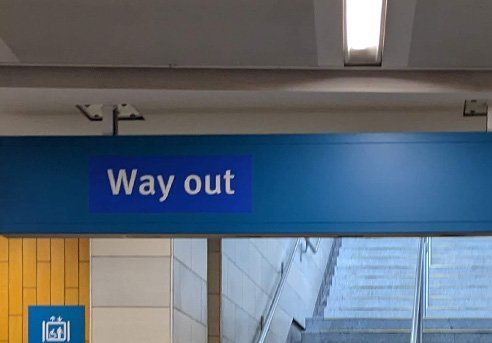Word count: 550 words
Reading time: About 2 minutes
Even simple words, such as “exit” can convey a freight of meanings. Always ensure you’re using exactly the right words.…
When I took my first ever ride on the Canada Line — Vancouver’s newish subway from downtown to the airport — I didn’t notice the quiet and cleanliness of the trains, although they certainly gleamed.
Instead, I became obsessed by the exit signs. Or, perhaps, I should say the absence of them. As J.P. Sartre might have put it, there was no exit! Instead, there were bright blue tags saying ‘way out.’ I was surprised by the terminology but after a nanosecond of thought, I found the new signage refreshing and easy to understand, although I wasn’t quite sure why. I tweeted about it and several people responded with comments like, “what’s wrong with exit?” and “‘way out’ is two words rather than one – isn’t it better to be shorter?”
I licked my wounds and decided to shut up. Then, a few months ago, my buddy Michael Katz happened to be in town from Boston and we ended up taking the train together. “What’s with those ‘way out’ signs?” he asked. (He’s a funny guy so he probably worked in a few jokes, too.) Michael, today’s column is for you!
Given that the Canada Line cost $2 billion, I figured some high-priced help had settled on the exact verbiage for the signs. It took me four phone calls and about six weeks to find the guy — Terry Heard, owner of the Toronto-based company, TH Design. Turns out he didn’t hire linguists or writers or even a semiotician. Instead, he counted on the London Underground to have done all that.
“We established ‘way out’ because that is the convention for London Transit,” Heard says. “They’ve been doing it a lot longer and they based their system on reactions from travelers over the last 50 years.”
While Heard believes that ‘way out’ is friendlier and more conversational than ‘exit’ (and I agree), I take his other argument far more seriously. “Emergency routes are always labeled ‘Exit,’” he says. “We don’t want anyone to confuse the way out with an official emergency exit that is governed by an entirely separate system under [building] code.”
Sure enough, just last week I saw some traditional ‘exit’ signs in the tunnel, in spots from which you’d never want to have to escape (because it would involve the type of emergency you might see on a Law and Order episode.)
Heard’s comment made me suddenly understand my initial positive reaction to the signs. If I’d seen ‘exit’ I might have unconsciously dithered — did it mean an exit to the street or an emergency exit? Instead, ‘way out,’ let me know that it was, simply, the best way to leave the station.
Writing signs is a special kind of responsibility — far more serious (because readers are often distracted, stressed and in a hurry) than many other types of writing. Nevertheless, it makes sense to truly attend to the individual words you use, whatever the writing you’re doing.
I stand with Mark Twain who said, “The difference between the almost right word and the right word is really a large matter — it’s the difference between the lightning bug and the lightning.”
When you’re editing your own work, be sure you’re not bugging your readers, when what you really want to communicate is a big flash across the sky.


